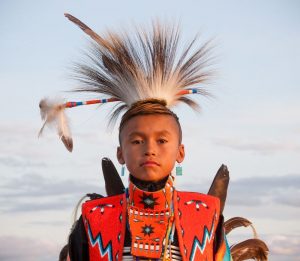
Coming soon is a new multi-media educational resources born out of the long friendship between urban white photographer, Sue Reynolds, a lifelong Episcopalian, and Salish Indian poet and venerated member of the Salish Kootenai Tribes, Victor Charlo. Named Everyday Native, it is the first collaborative teacher’s resource created by non-Natives and Native Americans to focus on the daily lives of Native youth. It sparks discussion and understanding among 4ththrough 12th grade students about the experiences of navigating the two worlds of Native and non-Native life, including racism that contributes to higher than national average rates of suicide among Native youth ages 15-24 years old. Through such topics as biculturalism, family, reclaiming culture, and bullying, Everyday Native aims to fuel a movement of new, more accurate perceptions about and respect between non-Native and Native peoples.
Everyday Native is garnering early praise from teachers in Montana, South Dakota, Idaho, and California for exquisite photography, breathtaking poems and content that offers extended learning opportunities. These educators welcome its positive message and how it dispels stereotypes of Native peoples.
The content – which enriches Language Arts, Native American History, U.S. History, Social Studies, Current Events, Art and more — is reviewed by Lakota and Salish educators to ensure accuracy and cultural sensitivity.
Creating Social Consciousness: Bridging the Gap between Native and non-Native Youth
“Leo wears his hair in the three-braid style that is traditional for Blackfeet boys. His hair and light skin have created problems for him.” So begins theEveryday Native chapter, “Walking in Two Worlds,” with the story of Leo Kipp who now lives on the Blackfeet Reservation in western Montana. Students learn about Leo’s life helping on his grandparents’ ranch, learning his indigenous language at an immersion school, and dealing with the painful circumstances of racial bullying, whether it’s being teased for his braids or being targeted for his light skin. Each chapter of Everyday Native includes discussion and writing sections that follow Native youths’ stories, tribal histories, and culture. Sections ask students to think about highlighted youths’ experiences and also relate them to their own. Project ideas take learning beyond classrooms and into communities.
Everyday Native was created by founder-photographer Sue Reynolds with educator Cass Fey, former education director for The Center for Creative Photography at the University of Arizona, Tucson. Both are non-Native. Beautiful, eye-opening poems by Salish Indian poet Victor Charlo appear throughout the resource, providing insights into this renowned storyteller’s everyday life on and off the reservation. Reynolds stays in touch with many Native families seen in the resource so that updates help keep website content accurate and relevant.
Everyday Native launches in late July. Once it goes live, teachers, students, parents, and the public can go to www.everdaynative.com to register for a free account, and before launch they can sign up for launch notification.
Social Documentary Network Exhibit: Introducing New Photos and Narratives
To see expanded photos and stories about Native youth and their communities featured in Everyday Native, a photo exhibit curated by founder Sue Reynolds is on view now at Social Documentary Network. Featured are never seen-before photos and new stories about Native youth on the Nez Perce, Flathead, Blackfeet and Standing Rock Reservations.
Cross-Cultural Collaboration: A Long Friendship
Everyday Native was born out of the long friendship between an urban white photographer, Sue Reynolds and a Salish Indian poet and venerated member of the Salish Kootenai Tribes, Victor Charlo. Reynolds’ and Charlo’s first collaboration included a photo-poetry book, Still Here: Not Living in Tipis (2013), which saw success and also recognition from then U.S. Congressman George Miller and California State Senator Mark DeSaulnier. Both Reynolds’ and Charlo’s works help heal racism and have appeared in national and international outlets.
- Everyday Native is a free 4th-12th grade teacher’s resource created to help bridge the gap of understanding between non-Native and Native American youth. Starting in late July 2018, teachers, parents and the public can access it atwww.everydaynative.com.
- Everyday Native is the first collaborative teacher’s resource created by non-Natives and Native Americans to focus on the daily lives of Native youth.
- Suicide is 2.5 times the national rate and the second leading cause of death for Native American youth, in part due to historical and present day racism.
- Everyday Native’s goal is to help reduce racism by asking students to reflect on the daily lives of Native youth, who walk the two worlds of non-Native and Native life.
- Everyday Native emphasizes the everyday life of Native Americans as opposed to popular stereotypes created by movies, TV, books and news media.
- Everyday Native enhances the study of many subjects, including Language Arts, Native American History, U.S. History, Social Studies, Current Events, Photography, Poetry, and Art.
- Founder-photographer Sue Reynolds created the photographs in Everyday Native over 12 years and more than 50,000 miles visiting Indian reservations.
- Revered Salish Indian poet and elder Victor Charlo wrote the poems that appear in Everyday Native based on his life on and off the reservation over the past 50 years.
- Everyday Native features photos and stories of 12 Native American families and is reviewed by Lakota and Salish educators. Teacher-reviewers say “The photography is exquisite, the poems breathtaking. There are extended opportunities for learning.”
images by Sue Reynolds
main image: Tiyapo Campbell Shows How He Dresses an Elk, Nez Perce Reservation, Idaho, 2017 by Sue Reynolds

